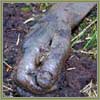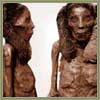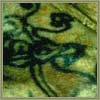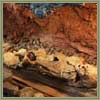|
For many people the word "mummy" conjures up images of linen-wrapped
royalty from ancient Egypt. But for scientists it describes any body
that retains soft tissue—most often skin, but sometimes even
eyes and internal organs—long after death. Peat bogs in Europe
made mummies, and so did a cave in Greenland and a mountaintop in
Argentina. In this slide show, examine both natural forces and
artificial techniques that have created a wide range of mummies
around the world.—Susan K. Lewis


|
|
Bog Bodies
Northern Europe
The key to the remarkable preservation of bog bodies, as with
all mummies, was that bacteria and fungi, nature's agents of
decay, couldn't carry out their usual work. For many years it
was assumed that merely the acidic, oxygen-free environments
of peat bogs kept microbes away. But recently a new
explanation has emerged: a substance called sphagnan, found in
the Sphagnum moss that blankets many bogs, acts as an
antibiotic. Sphagnan also tans skin, giving bog bodies their
characteristic coffee color.
|


|
|
Natural Mummies
Egypt
Centuries before the art of embalming or "artificial"
mummification was developed in Egypt, bodies were naturally
mummified in pits dug into the desert sands. These arid graves
were inhospitable to fungi and bacteria, which need water to
thrive. In addition to being relatively microbe-free, the
desert in Egypt is rich in a mineral called natron that
contains both salt and baking soda; it's an ideal disinfectant
and desiccant that drew the moisture from buried corpses and
kept them more or less pristine.
|


|
|
Classic Mummies
Egypt
Most of the well-known royal mummies of ancient Egypt were
prepared for eternal life through an elaborate process called
classic mummification. It involved the removal of all internal
organs other than the heart, which Egyptians believed was the
source of intelligence. Embalmers then cleansed the body with
wine, dried it for 40 days in natron, made it supple with
oils, and wrapped it in resin-coated linen bandages, which
protected it from oxygen, microbes, and moisture.
|


|
|
Pazyryk Mummies
Southern Siberia
Mummies discovered in the Altay Mountains of southern Siberia
were shielded from decay by both natural and artificial means.
Pazyryk embalmers removed internal organs and muscles, then
stitched skin back together with horsehair thread. The bodies
were buried in graves marked by great mounds of stones that
allowed water to seep down and deflected the sun's heat. This,
together with long winters, kept the ground below permanently
frozen, safeguarding woolen rugs, sacrificed horses, and the
embalmed human corpses.
|


|
|
Lady Dai
Central China
She's been called the best-preserved mummy in the world. When
unearthed in 1971, her flesh body was still supple, and her
veins contained type-A blood. What accounts for her
conservation? Some researchers point to her airtight coffin.
Like a Russian doll, her coffin lay nested in a series of six
caskets, and the entire burial chamber, with over 1,000 Han
Dynasty artifacts, was encased in charcoal and clay 50 feet
underground. Other scientists suspect that a mercury bath
after death was her ticket to immortality.
|


|
|
"Ötzi" the Iceman
Northern Italy
When hikers in the Ötztal region of the Italian Alps
stumbled upon this man's corpse, his unusual bearskin cap and
copper axe hinted that he wasn't modern. Indeed, radiocarbon
dating confirmed that "Ötzi," as he is affectionately
known, lived between 3350 and 3100 B.C. An arrow shot into his
back killed this Stone Age man, but conditions in his glacial
tomb gave him an afterlife. His body, first buried in snow and
then embedded in ice, remained deep-frozen for over 5,000
years.
|


|
|
Ürümchi Mummies
Northwestern China
In the windswept desert region near the city of
Ürümchi, China, dozens of natural mummies have come
to light, conserved by dry and salty sands as well as severely
cold winters. These 3,000- to 4,000-year-old bodies are
surprising not just because they retain lifelike features, but
because many of these features, including reddish-blond hair
and long, narrow noses, seem distinctly Caucasian.
Archeologists think these people may have belonged to an
ancient civilization that existed at the crossroads between
Europe and China.
|


|
|
Guanche Mummies
Canary Islands
The Guanche people mummified their dead for centuries before
Spain conquered the Canary Islands in 1402. Most of the
mummies have disappeared, but historic sources describe the
embalming process, and at least one mummy survived. His body
had been eviscerated, smeared with sheep butter, and dried in
the sun for several weeks. The body cavity had then been
filled with sand and other packing material, stitched up,
wrapped in animal skins, and laid to rest in a funerary cave.
|


|
|
Qilakitsoq Mummies
Greenland
In 1972, hunters roaming near an abandoned Inuit settlement
called Qilakitsoq chanced upon the graves of eight people. Six
women and two children had been buried in the mid-15th century
beneath an overhanging rock that sheltered the burial site
from sunlight, rain, and snow. Slowly but steadily, dry winds
and subzero temperatures freeze-dried their remains as well as
their sealskin and fur clothing. Museum curators today
sometimes use a similar process of freeze-drying to conserve
unearthed bog bodies and organic artifacts.
|


|
|
Incan Mummies
Andes Mountains
While ritual sacrifices were rare in Incan culture, explorers
have discovered dozens of sites where such ceremonies took
place. Those sacrificed were invariably children, whose purity
made them fit to enter the realm of the mountain gods. Frozen
for over 500 years, their bodies retain beautifully braided
hair, internal organs, even eyelashes. They are also stirring
reminders that, no matter how they appear today, each mummy
was once a living, breathing person.
|

|

|

